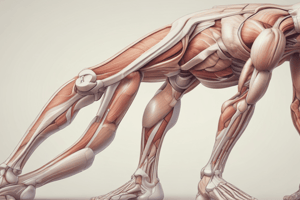Podcast
Questions and Answers
What is the primary cause of this condition?
What is the primary cause of this condition?
- Excessive glycogen storage
- Deficiency of glycogen phosphorylase (correct)
- Insufficient insulin production
- Excessive fatty acid oxidation
Which symptom is NOT commonly associated with this condition?
Which symptom is NOT commonly associated with this condition?
- Difficulty with prolonged exercise
- Muscle pain after exercise
- Enhanced athletic performance (correct)
- Exercise intolerance
What diagnostic method is used to confirm enzyme deficiency in this condition?
What diagnostic method is used to confirm enzyme deficiency in this condition?
- X-ray imaging
- Blood pressure measurement
- Muscle biopsies (correct)
- Electrocardiogram (ECG)
What is a recommended lifestyle modification for managing symptoms?
What is a recommended lifestyle modification for managing symptoms?
Which statement about the treatment of this condition is true?
Which statement about the treatment of this condition is true?
Which function does the quadriceps femoris primarily perform?
Which function does the quadriceps femoris primarily perform?
What is the primary function of the hamstring muscles?
What is the primary function of the hamstring muscles?
Which muscle group is responsible for dorsiflexion of the ankle?
Which muscle group is responsible for dorsiflexion of the ankle?
What muscle is primarily involved in internally rotating the arm?
What muscle is primarily involved in internally rotating the arm?
What type of muscle is responsible for involuntary movements within internal organs?
What type of muscle is responsible for involuntary movements within internal organs?
Which muscle is the largest in the buttock region?
Which muscle is the largest in the buttock region?
What muscle group is involved in bringing the thighs together?
What muscle group is involved in bringing the thighs together?
Which of the following correctly describes McArdle Syndrome?
Which of the following correctly describes McArdle Syndrome?
Flashcards
McArdle's Disease
McArdle's Disease
A condition caused by a lack of the enzyme glycogen phosphorylase, which stops muscles from properly using stored energy (glycogen).
Myalgia
Myalgia
Muscle pain and cramps that happen after exercise.
Muscle Biopsy
Muscle Biopsy
A test that involves taking a sample of muscle tissue to examine under a microscope, looking for problems with enzymes or other cell components.
Genetic Testing
Genetic Testing
Signup and view all the flashcards
Prognosis
Prognosis
Signup and view all the flashcards
Quadriceps Femoris
Quadriceps Femoris
Signup and view all the flashcards
Hamstrings
Hamstrings
Signup and view all the flashcards
Gluteus Maximus
Gluteus Maximus
Signup and view all the flashcards
Adductors
Adductors
Signup and view all the flashcards
Gastrocnemius
Gastrocnemius
Signup and view all the flashcards
Soleus
Soleus
Signup and view all the flashcards
Tibialis Anterior
Tibialis Anterior
Signup and view all the flashcards
Skeletal Muscle
Skeletal Muscle
Signup and view all the flashcards
Study Notes
Leg Muscle Labelling and Functions
- Quadriceps Femoris: A group of four muscles in the front of the thigh, extending the knee joint.
- Rectus Femoris
- Vastus Lateralis
- Vastus Medialis
- Vastus Intermedius
- Hamstrings: Located on the back of the thigh, flexing the knee and extending the hip.
- Biceps Femoris
- Semitendinosus
- Semimembranosus
- Gluteus Maximus: The largest buttock muscle, extending and externally rotating the hip.
- Gluteus Medius and Minimus: Deep to gluteus maximus, abducting and medially rotating the hip.
- Adductors: Inner thigh muscles, adducting (bringing together) the thighs.
- Gastrocnemius: Calf muscle, plantar flexing the ankle (pointing toes down).
- Soleus: Deeper calf muscle, plantar flexing the ankle.
- Tibialis Anterior: Front lower leg muscle, dorsiflexing the ankle (pulling toes up) and inverting the foot.
- Peroneus Longus and Brevis: Lateral lower leg muscles, everting the foot.
- Tibialis Posterior: Deep lower leg muscle, plantar flexing the ankle and inverting the foot.
General Main Muscles of the Body and Their Functions
- Biceps Brachii: Flexes the elbow and supinates the forearm (turns palm up).
- Triceps Brachii: Extends the elbow joint.
- Pectoralis Major: Adducts and flexes the arm, internally rotates it.
- Latissmus Dorsi: Extends, adducts, and medially rotates the arm.
- Trapezius: Elevates, retracts, and rotates the scapula (shoulder blade).
- Deltoid: Abducts the arm, assisting in flexion and extension.
- Rectus Abdominis: Flexes the trunk.
- Erector Spinae: Extends the spine.
- Gluteus Medius & Minimus: Abducting the hip.
- Iliopsoas: Hip flexor.
- Diaphragm: Primary muscle of respiration.
- Intercostals: Assist with respiration.
Different Types of Muscle Cells
- Skeletal Muscle: Voluntary, striated, multinucleated. Attached to bones, responsible for movement.
- Smooth Muscle: Involuntary, non-striated, single nucleus. Found in internal organs (e.g., digestive tract, blood vessels), responsible for involuntary movements.
- Cardiac Muscle: Involuntary, striated, single nucleus. Found only in the heart, responsible for pumping blood.
McArdle Syndrome
- Description: A genetic muscle-metabolic disorder.
- Cause: Deficiency in glycogen phosphorylase, an enzyme for breaking down glycogen into glucose.
- Symptoms:
- Muscle pain (myalgia) and cramps after exercise
- Muscle weakness and fatigue after exertion
- Difficulty with prolonged exercise
- Exercise intolerance
- Possible cardiac arrhythmias
- Diagnosis: Based on symptoms, physical examination, muscle biopsies, and genetic testing.
- Treatment:
- Symptom management, minimizing pain and fatigue.
- Dietary strategies to prevent intense workouts.
- Lifestyle modifications, like pacing exercise, to manage symptoms.
- Currently no drugs to directly address the syndrome.
- Prognosis: Symptoms vary significantly, depending on severity and treatment timing.
Studying That Suits You
Use AI to generate personalized quizzes and flashcards to suit your learning preferences.



